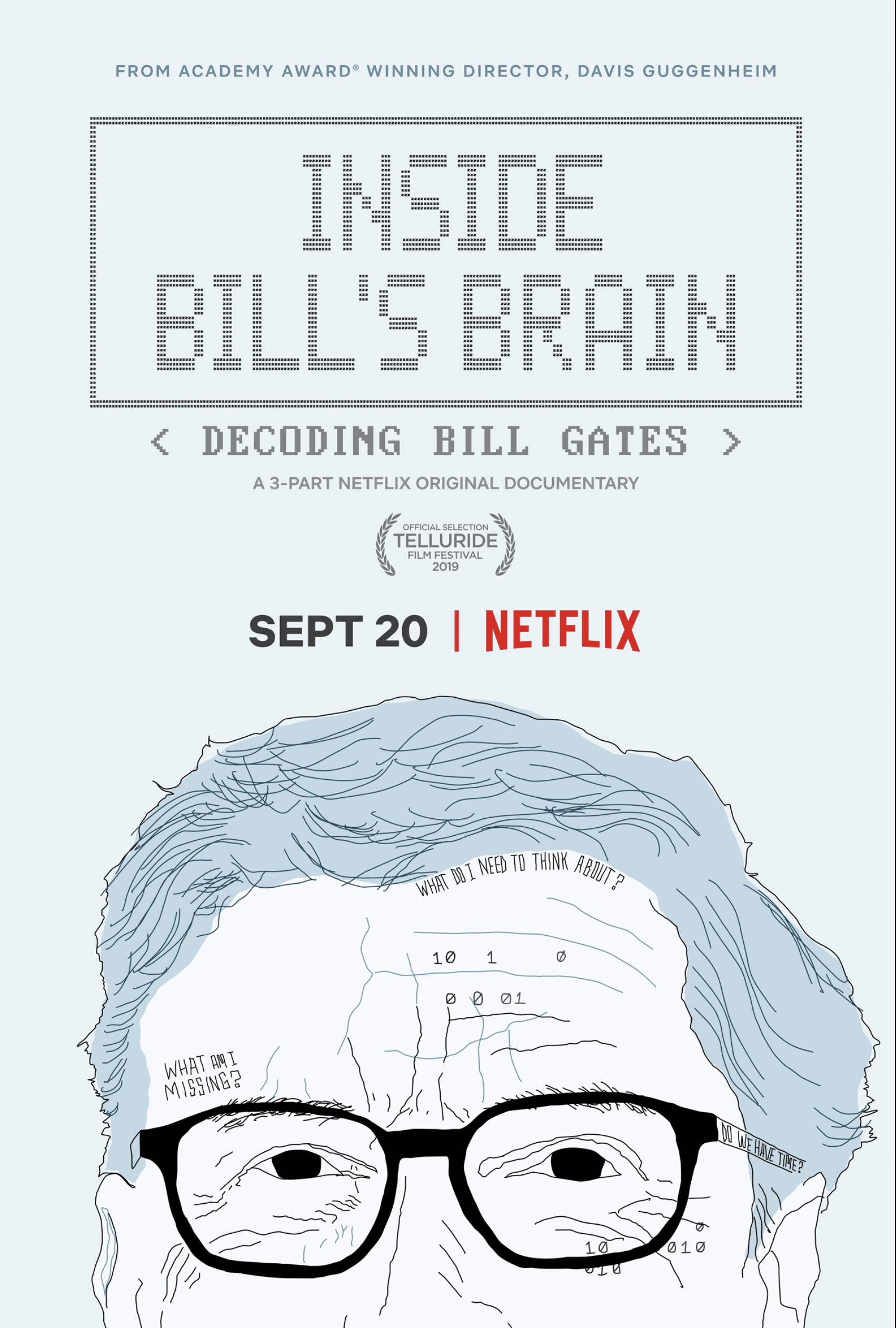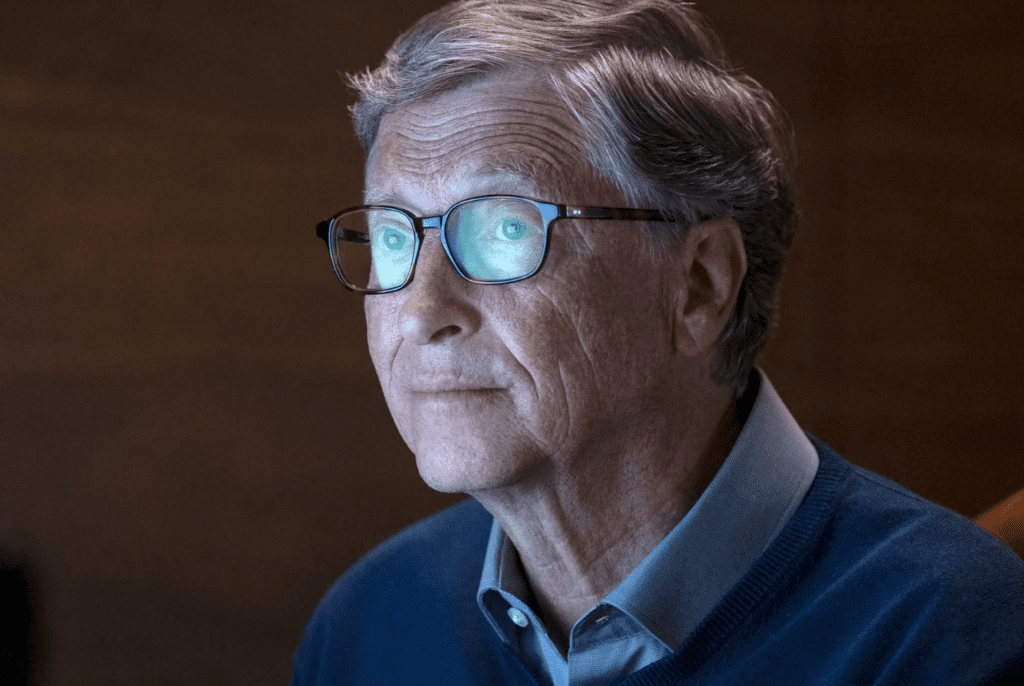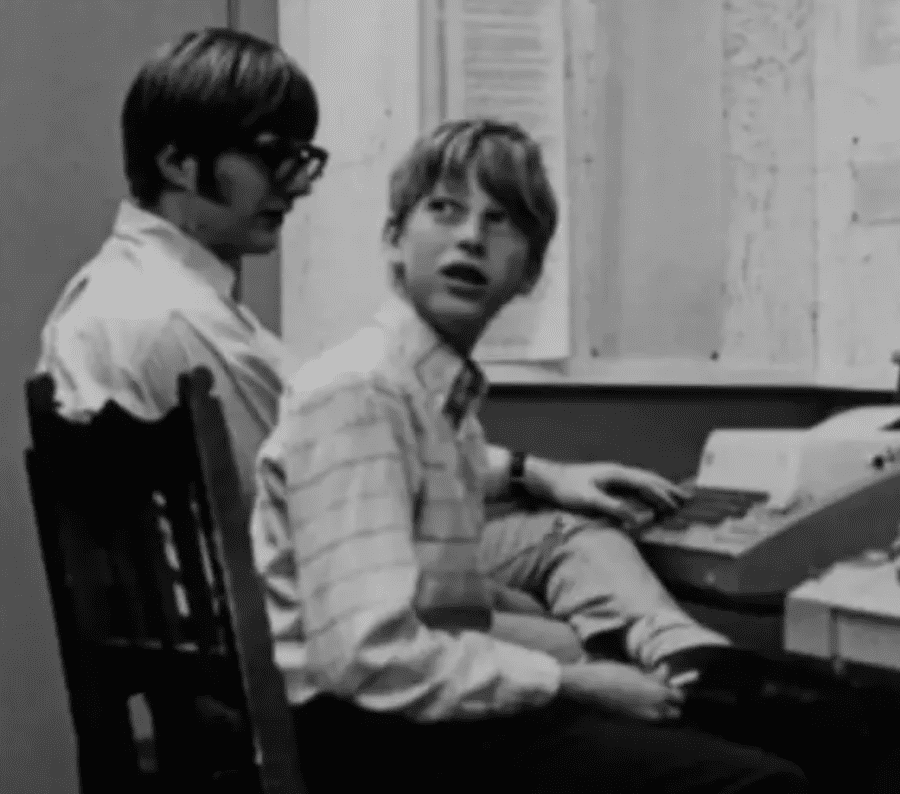Inside Bill’s Brain – Decoding Bill Gates

Inside Bill’s Brain – Decoding Bill Gates – A three-part docuseries explores the mind and motivations of the celebrated tech visionary, business leader and philanthropist.
A documentary that tells Bill Gates’ life story as he pursues solutions to some of the world’s most complex problems.
In his relentless pursuit to try to solve some of the world’s most pressing problems around sanitation, disease eradication and climate change, Bill Gates is practically robotic in his quest for information and in his inability to give up.
Inside Bill’s Brain – Decoding Bill Gates – It’s glimpses of the Microsoft co-founder’s human side that help power “Inside Bill’s Brain: Decoding Bill Gates
Software magnate Bill Gates is one of the most famous people in the world, but the public barely knows him.
Gates has been a household name for decades for two reasons: he was the face of Microsoft during an era when the company’s products became ubiquitous, and, perhaps more notably, he’s very, very rich.
Yet, he’s never been the kind of celebrity whose personal life and political opinions are splashed across the tabloids and social media.
And unlike the late Steve Jobs — his contemporary and occasional rival — Gates is rarely discussed in terms of some ineffable mystique.
Inside Bill’s Brain – Decoding Bill Gates – The title of Davis Guggenheim’s three-part Netflix documentary Inside Bill’s Brain: Decoding Bill Gates (which debuts on Friday, September 20th) speaks to its subject’s opacity.
What makes one of the world’s wealthiest people tick? What formed him? How did he come to dominate a fiercely competitive industry so thoroughly that the US government sued Microsoft under antitrust statutes?

Inside Bill’s Brain – Decoding Bill Gates
Each episode of Inside Bill’s Brain focuses on one of the foundation’s major initiatives: improving sewage conditions in developing countries, eradicating polio, and developing a cleaner, safer form of nuclear power.
Each of the three parts shifts rapidly between interviews, biographical material, and fly-on-the-wall footage of the Gates team’s philanthropic missions.
Guggenheim eschews traditional transitions, and instead jumps from subject to subject, even when there’s no clear connection between them.
The point, apparently, is to replicate Bill Gates’ thought processes. Having spent most of his adult life (and even some of his teenage years) juggling multiple complicated projects, Gates doesn’t have the kind of mind that functions in neat, straight lines
Directed by Academy Award winner Davis Guggenheim (“An Inconvenient Truth”), the series is at times an intimate and revealing look at Gates’ life, from his upbringing to his education, his family and friendships, the drive to make Microsoft a global powerhouse, the transition to philanthropy, and his love for and partnership with wife Melinda Gates.
For those familiar with many of the benchmarks and anecdotes from Gates’ long life in the public eye, there are repeated tales of his accomplishments and idiosyncrasies.
They are spliced throughout three 50-minute episodes with footage from his home and offices in Seattle to far-flung locations around the planet.
Stories from his two sisters, his wife, current and former co-workers, friends, and the voice of the late Microsoft co-founder Paul Allen are used to illustrate what many think they know when it comes to what is going on “Inside Bill’s Brain.”
Inside Bill’s Brain – Decoding Bill Gates – The Episodes
Season 1, Episode 1
Bill Gates speaks about his life-or-death mission to get better sanitation to the developing world; his sisters share their childhood memories.
Season 1, Episode 2
The connections that shaped Gates’ life come into focus, including a childhood friendship and his unique bond with Microsoft co-founder Paul Allen.
Season 1, Episode 3
The search for climate change solutions requires passion, resources and a sense of urgency — three qualities Gates clearly possesses.
Inside Bill’s Brain – Decoding Bill Gates – World Impact
Inside Bill’s Brain – Decoding Bill Gates – Gates was also known for his charitable work.
With his then wife, Melinda, he launched the William H. Gates Foundation (renamed the Bill & Melinda Gates Foundation in 1999) in 1994 to fund global health programs as well as projects in the Pacific Northwest.
During the latter part of the 1990s, the couple also funded North American libraries through the Gates Library Foundation (renamed Gates Learning Foundation in 1999) and raised money for minority study grants through the Gates Millennium Scholars program.
In June 2006 Warren Buffett announced an ongoing gift to the foundation, which would allow its assets to total roughly $60 billion in the next 20 years.
Inside Bill’s Brain – Decoding Bill Gates – At the beginning of the 21st century, the foundation continued to focus on global health and global development, as well as community and education causes in the United States.
After a short transition period, Gates relinquished day-to-day oversight of Microsoft in June 2008—although he remained chairman of the board—in order to devote more time to the Bill & Melinda Gates Foundation.
In February 2014 he stepped down as chairman but continued to serve as a board member until 2020.
During this time he was awarded the Presidential Medal of Freedom (2016).

Inside Bill’s Brain – Decoding Bill Gates – Gates Foundation
Bill Gates, one of the first faces of the personal computer, has seen several reboots of his public image.
The Microsoft co-founder became the whizkid of software in the 1980s, and the personal-computing industry’s first billionaire at age 31.
Now, at age 63 and 19 years after stepping down as Microsoft’s CEO, he’s known for marshaling his massive wealth to try to solve intractable problems on a global level.
The Gates foundation has made more than $50 billion in total grant payments since the founding of the first Gates family philanthropy, originally named for Mr. Gates’s father, in 1994.
The foundation is organized into five program areas: Global Development Division, Global Health Division, United States Division, and Global Policy & Advocacy Division.
Polio eradication, climate change, sanitation and nuclear power are some of the areas that the Gate’sFoundation has made significant contributions and advances for all of mankind.
Bill says that all the problems he takes on require a lot of participation, whether it’s scientists, or governments, or brilliant people in the field.
He goes on to say that you won’t be successful unless you can talk to broad audiences and shift perceptions.
Eradicating Polio
Eradicating polio depends on stability in Afghanistan and the political priority we get in Pakistan.
Nigeria required a lot of super intense work, particularly in the northeast where Boko Haram showed up.
Any time you do a disease eradication you’ll end up in the most unstable and difficult places in the world.
We didn’t really expect that.
But you adjust and focus in. That’s why you need to build these teams with gigantic, diverse skillsets.
I’m good at thinking how the pieces fit together conceptually but then there’s massive amounts of work and communication required.
Sanitation, Toilets & Diarrhea
More than 3.5 billion people around the world live without safely managed sanitation.
Inadequate sanitation and hygiene are estimated to have caused more than half a million deaths from diarrhea alone in 2016.
Safe sanitation is essential to a healthy and sustainable future for developing economies.
The Gates Foundation focuses on accelerating innovations in non-sewered sanitation technology and service delivery, particularly in densely populated areas of South Asia and sub-Saharan Africa.
Since 2011, our foundation’s Reinvent the Toilet Challenge has worked with leading engineers and scientists to design low-cost toilets that do not require connections to the electrical grid, water supply, or sewers.
Several designs that debuted at the Reinvented Toilet Expo in 2018 are now commercially available.
These toilets work using internal combustion and chemical treatment systems, and they can be set up in areas that are hard to reach with traditional infrastructure.
They can deliver the same benefits as toilets connected to sewers, plus wholly new benefits that include the removal of human pathogens and generation of usable water and electricity.
Some reinvented toilet models provide sanitation for single homes, while others are designed for public or shared toilet facilities that serve communities.
Inside Bill’s Brain – Decoding Bill Gates – Backdrop
Inside Bill’s Brain – Decoding Bill Gates – Bill Gates is a technologist, business leader, and philanthropist.
He grew up in Seattle, Washington, with an amazing and supportive family who encouraged his interest in computers at an early age.
He dropped out of college to start Microsoft with his childhood friend Paul Allen.
Gates wrote his first software program at the age of 13.
Bill has two sisters.
His late father, William H. Gates Sr., was a Seattle attorney and one of the co-chairs of the Bill & Melinda Gates Foundation.
His late mother, Mary Gates, was a schoolteacher, University of Washington regent, and chairwoman of United Way International.

Inside Bill’s Brain – Decoding Bill Gates – Backdrop
William Henry Gates III is an American business magnate, software developer, investor, author, and philanthropist.
He is a co-founder of Microsoft, along with his late childhood friend Paul Allen.
Born: October 28, 1955 (age 66 years), Seattle, WA
Net worth: 131.9 billion USD (2022) Forbes
Gates was a college dropout.
He left Harvard University in 1975 to fully devote himself to Microsoft.
Gates wrote his first software program at the age of 13.
In high school he helped form a group of programmers who computerized their school’s payroll system and founded Traf-O-Data, a company that sold traffic-counting systems to local governments.
Remarkably, he has only graduated from one institution: that would be Lakeside School, the Seattle prep school where he was class of ’73.
In 1975 Gates, then a sophomore at Harvard University, joined his hometown friend Paul G. Allen to develop software for the first microcomputers.
They began by adapting BASIC, a popular programming language used on large computers, for use on microcomputers.
With the success of this project, Gates left Harvard during his junior year and, with Allen, formed Microsoft.
Microsoft licensed an operating system called MS-DOS to IBM then the world’s biggest computer supplier and industry pacesetter—for use on its first microcomputer, the IBM PC (personal computer).
After the machine’s release in 1981, IBM quickly set the technical standard for the PC industry, and MS-DOS likewise pushed out competing operating systems.
While Microsoft’s independence strained relations with IBM, Gates deftly manipulated the larger company so that it became permanently dependent on him for crucial software.
Makers of IBM-compatible PCs, or clones, also turned to Microsoft for their basic software.
By the start of the 1990s he had become the PC industry’s ultimate kingmaker.
Gates says he reads 50 books a year. “Reading is still the main way that I both learn new things and test my understanding,” he says.
Books are a constant in the Gates family’s home library.
Gates lugs a stuffed tote bag everywhere he goes – the bag is reloaded weekly and cleaned frequently.
At Microsoft, Gates used to memorize employees’ license plates to keep tabs on their comings and goings. “Eventually I had to loosen up, as the company got to a reasonable size,” he said.
Inside Bill’s Brain – Decoding Bill Gates – Memorable Quotes
“He is on time to the minute, every single meeting without fail. Time is the one commodity that he can’t buy more of. It’s a limited resource. It’s finite. He’s got the same 24 hours in a day that the rest of us have.” — Lauren Jiloty, Gates Ventures.
“I’ve never heard him complain about [Melinda]. He’s the only person on this earth who I’ve never heard complain about his wife.” — Mike Slade, one-time Microsoft arketing chief.
“She never thought my table manners were perfect. I don’t think I’ve solved that. So she’d still have things that she’d encourage me to do better on.” — Bill Gates, on his mother.
“I’ve been with him on vacation and he’ll read 14 books,” friend Bernie Noe recalled. “That’s a gift, to read 150 pages an hour. I’m gonna say it’s 90 percent retention. Kind of extraordinary.”
We had a lot of fun. I had never gotten drunk and Paul got me drunk. Paul was into Jimi Hendrix and there was the song ‘Are You Experienced?’” — Bill Gates.
“Bill and I were yin and yang. There was a stylistic difference in terms of intensity.” — Paul Allen.
“A key advantage I had was being fanatical, that is taking all my capabilities day and night and just focusing on, ‘OK, how do I write good software? I didn’t believe in weekends. I didn’t believe in vacation.” — Bill Gates
“Any problem I will look at how technical innovation can help solve that problem,” Gates said. “It’s the one thing I know and the one thing I’m good at. That’s my hammer. And a lot of problems look like nails, because I’ve got a hammer.”
Besides his plane, one of Gates’ biggest splurges was the Codex Leicester, a collection of writings by Leonardo da Vinci. He acquired it at a 1994 auction for $30.8 million.
Despite his immense wealth, Gates says his kids will only inherit $10 million each — just a fraction of his $130 billion net worth. “Leaving kids massive amounts of money is not a favor to them,” he says.
Inside Bill’s Brain – Decoding Bill Gates – is partly devoted to humanizing America’s original geek mogul, with scenes of Mr. Gates playing bridge with pal (and Foundation trustee) Warren Buffett and lugging an ever-present tote bag full of books.
Melinda Gates recalls finding her then-boyfriend writing factors for and against marriage on a whiteboard. “He’s not just a giant brain. He does have big passions, but he’s not steered by emotions,” says series director Mr. Guggenheim.
The documentary series Inside Bill’s Brain: Decoding Bill Gates appeared in 2019.
Two years later Gates and his wife divorced.
The Rise of the Lakers Dynasty on HBOmax >>
What to Binge Watch on Netflix >>
What to Binge Watch on Amazon Prime >>
What to Binge Watch on HBO, Paramount + & Showtime >>



